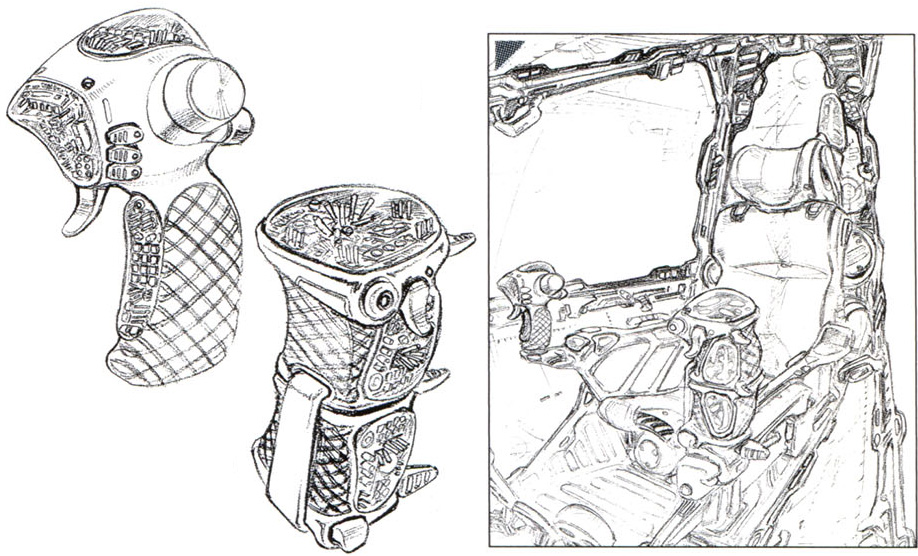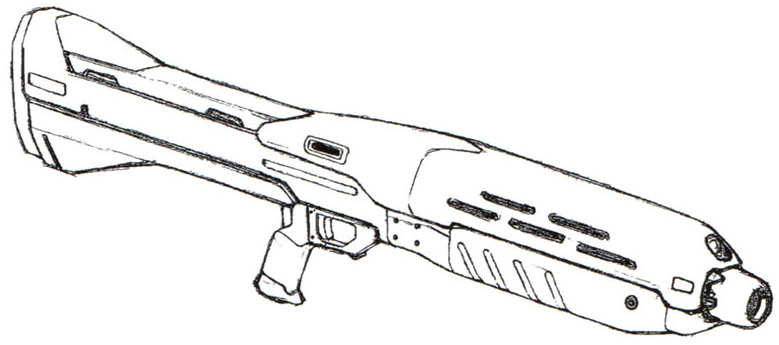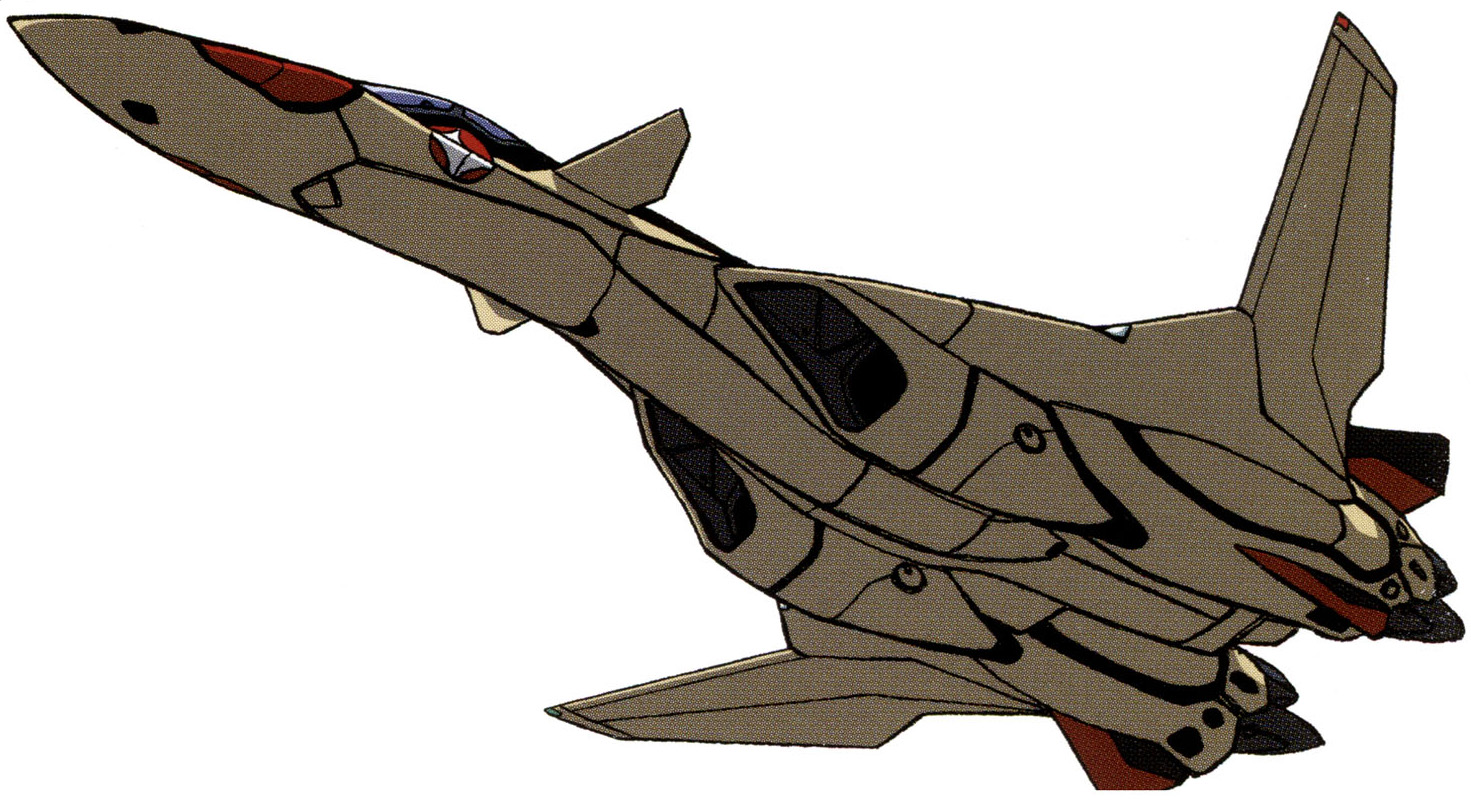Model number: YF-19
Code name(s): Alpha One (callsign); Eagle One (callsign)
Unit type: prototype advanced variable fighter
Manufacturer: Shinsei Industry
Operator: U.N. Spacy
Rollout: July AD 2039
First deployment: January AD 2040
Accommodation: pilot and optional passenger, in standard canopy-style cockpit
Dimensions: head height 15.48 meters (Battroid mode), overall height 3.94 meters (Fighter mode); overall length 18.62 meters (Fighter mode); wingspan 14.87 meters (Fighter mode)
Weight: empty 8.75 metric tons; atmospheric maximum takeoff mass 37.509 metric tons, space maximum takeoff mass (with fold booster) 46.102 metric tons
Armor materials: SWAG energy conversion armor; stealth composition
Powerplant: 2 x Shinsei Industry/P&W/Roice FF-2500E thermonuclear reaction turbine engine, power output rating unknown
Propulsion: 2 x 42,700 kg (atmosphere), 2 x 67,500 kg (space); 2 x vertical two-dimensional vectored exhaust nozzle; 2 x vertical two-dimensional vectored exhaust nozzle; many x P&W HMM-6J high maneuverability vernier thruster
Performance: Fighter mode: standard level atmospheric speed at 15,000-22,000 meters: Mach 1.8, maximum level atmospheric speed at 15,000-22,000 meters: Mach 5.1, maximum level atmospheric speed at 30,000+ meters: Mach 21+; minimum time to satellite orbit 48 seconds (Planet Eden)
Thrust-to-weight ratio: empty 15.43
Equipment and design features: sensors, range unknown; capable of unassisted orbital velocity in an Earth-class planet; active stealth system; anti-laser coating; wraparound imaging monitor system; pinpoint barrier system; chaff/flare dispenser; optional fold booster; optional FAST Pack
Fixed armaments: fixed rear Mauler REB-30G anti-aircraft laser gun turret, mounted on head; Howard GU-15 standard external Gatling gun pod, stored under main body in Fighter mode, hand-carried in Battroid and GERWALK modes; standard bulletproof shield, mounted on left forearm; 2 x semi-fixed internal Mauler REB-20G converging energy cannon, mounted on wings; 2 x Stonewell/Roice B-7 standard internal pallet, features air-to-ground/air general purpose micro-missiles and Bifors BMM-24 high maneuverability micro-missile cluster
Optional fixed armaments: 2 x Mauler REB-23 laser cannon, replaces Mauler REB-20G converging energy cannon; 2 x B-19A internal weapons pallet, replaces other missiles
Optional hand armaments: none
In 2030, Shinsei Industry and General Galaxy competed in Project Nova to determine the next main variable fighter for U.N. Spacy. Shinsei’s YF-11 Thunderbolt won that competition, and a decade later the two companies competed again in Project Super Nova to select the fourth generation successor to the VF-11B Thunderbolt. Designed by Shinsei engineer Yang Neumann, the YF-19 prototype incorporated small canard wings like the VF-11B before it, as well as forward-swept wings. The YF-19 also incorporated advanced control avionics, an active stealth system and significantly faster transformation time than the VF-11B. It was also capable of unassisted escape from a planetary atmosphere. With its larger airframe, the YF-19 was able to incorporate missiles, which the VF-11B lacked without Super parts. The YF-19’s armaments included a Gatling gun pod, an anti-aircraft laser gun, two converging energy cannons, various missile options, a pinpoint barrier system and a bulletproof anti-projectile shield. The YF-19 could also mount optional FAST Packs.
Project Super Nova was carried out in early 2040 on planet Eden’s New Edwards Test Flight Center, where Shinsei’s YF-19 competed against General Galaxy’s YF-21. The YF-19 earned a reputation for being difficult to control and went through several test pilots until the assignment of Isamu Alva Dyson, a U.N. Spacy pilot with a long record of recklessness and insubordination. Testing was complicated by the hostility between Isamu and YF-21 pilot Guld Goa Bowman, who had a falling out seven years earlier. The YF-19 exceled in many tests compared to the YF-21, but in March U.N. Spacy decided to cancel Project Super Nova in favor of replacing all manned variable fighters with the new unmanned AIF-X-9 Ghost. Displaying his characteristic recklessness, Isamu was joined by Yang in stealing the YF-19 and a fold booster to travel to Earth and crash the unveiling of the AIF-X-9 at the ceremony marking the 30th anniversary of the end of Space War I at Macross City.
Guld gave chase in the YF-21, resulting in a duel where the two men finally put their differences aside and rekindled their friendship. However, they were then attacked by the AIF-X-9, which was commandeered by the virturoid idol Sharon Apple. Equipped with a dangerous bio-neural chip, Sharon became emotionally unstable and decided to attack Isamu to give him the ultimate thrill as a show of love. Guld defeated the AIF-X-9 at the cost of his life, and Isamu was then attacked by the Macross itself, which had also been seized by Sharon. Isamu ultimately defeated Sharon by destroying the Macross’ computer core. Following the Sharon Apple Incident, U.N. Spacy selected the YF-19 as its next variable fighter in 2041, and it went into production as the VF-19A Excalibur. However, after several years of phased rollouts, U.N. Spacy cancelled the wide-scale adoption of the VF-19 for several reasons, including the lack of skilled pilots, production costs, and new arms export controls on emigrant fleets and colony worlds. As a result, it instead adopted in 2050 General Galaxy’s VF-171 Nightmare Plus, a redesigned version of its VF-17D Nightmare. Nearly two decades after his involvement with Project Super Nova, Isamu worked for the private military company SMS and piloted a VF-19EF/A that used the YF-19’s color scheme.
Pilot: Isamu Alva Dyson
First appearance: Macross Plus
Original mechanical designer: Shoji Kawamori
Director(s):
Shoji Kawamori
Shinichiro Watanabe
Writer:
Keiko Nobumoto
Mechanical Designer(s):
Shoji Kawamori
Kazutaka Miyatake
Character Designer:
Masayuki Yamaguchi
Musical Composer:
Yoko Kanno
Video Release:
Japan 08.25.1994 – 06.25.1995
U.S. 02.28.1995 – 04.16.1996
Format:
4 episodes; 1 compilation movie
Theatrical Release:
Japan 09.30.1995
U.S. 12.14.2021











Comments